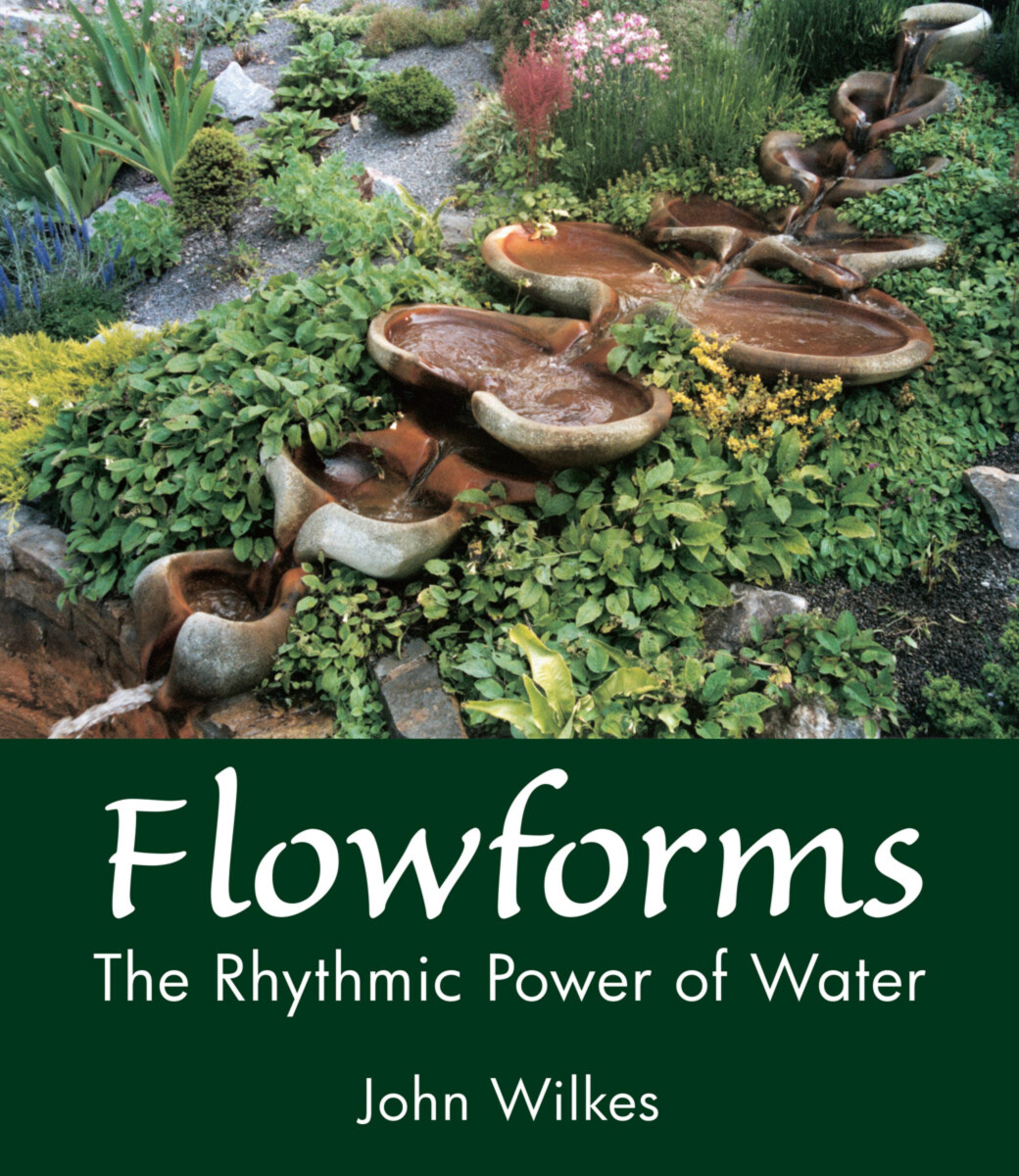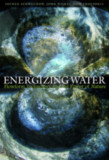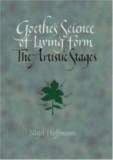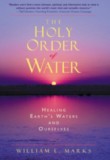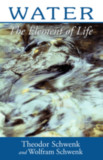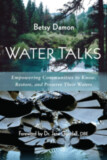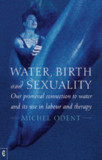Flowforms
The Rhythmic Power of Water
- Publisher
Floris Books - Published
24th May 2019 - ISBN 9781782505891
- Language English
- Pages 224 pp.
- Size 8" x 9.25"
What is the true nature of water, and does it have memory?
By working with the rhythm and flow of water, can we increase its life-giving power?
Water is not only fundamental to life but is ALSO essential for the cycles and changes in nature. John Wilkes states that water is the universal bearer of whatever character we put into it. Consequently, the way we treat water is of crucial importance to our health, and to the wellbeing of our planet.
Working with his remarkable invention, the Flowform, Wilkes has uncovered hidden secrets of the world of water, and at the same time created an artform of great beauty. His lifetime of applied research into rhythms and water, fully revealed in this book for the first time, has startling implications for such topical issues as farming and irrigation; food production and processing; water treatment and recycling; and health and cosmetic products.
This ground-breaking book is lavishly illustrated to show both the beauty of the Flowform and the wide range of its applications.
“With extraordinary depth of vision, Wilkes shares more than thirty years of accumulated ideas, experiments, experiences and creative, innovative designs with water. Benefits from many photographs and illustrations.” —Maggie Lee, Resurgence, May 2004
“John Wilkes patented his first flowform water sculpture over thirty years ago. This is the story of his studies into the nature and behavior of water and the pioneering development of the special water sculptures. Detailed accounts of research are richly illustrated, including many beautiful images of the swirling patterns. The book is full of both scientific observations and a celebration of the beauty and wonder of water, and the beauty and wonder of the sculptures it has inspired John Wilkes and his team to create.” —Kathleen Askew, Permaculture, March 2004
“One of the aims of the book is to raise our consciousness about water and get us to reassess our attitude to it and in this it most definitely succeeds. With the aid of copious photographs, drawings, and diagrams, our attention is drawn to how much life there is in water. I found this an extremely interesting, informative and attractive book.” —Rosemary Usselman, New View, Dec. 2003
“Contains many beautiful illustrations of water in motion, from rivers and waterfalls to the art of designing water features for a garden.” —Pentacle, spring 2004
INTERVIEW WITH JOHN WILKES
Jens Jensen: In your introduction, you say that “rhythms are fundamental to life” and that “moving water is inseparable from surface, either inner or outer.... So rhythm and surface are components that have to be investigated together.” We are all familiar with the “outer” surface of water, which is most obvious as, say, ripples on a lake. But what exactly do you mean by an “inner” surface of water?
John Wilkes: A jar of clear water will look basically the same, whether still or moving. If, however, you introduce an indicator like metal powder, veil-like forms will appear in the volume when the whole is gently moved, made visible by the suspended metal particles. When the water is allowed to remain still, form disintegrates and the particles sink to the bottom. Forms, or surfaces, appear only when movement is generated in the volume of water. Everyone can make this observation. All form is generated through movement. Take a dropper with some color and allow a drop to fall a centimeter or two into still water. A ring vortex will be created. Observe closely what happens. Surfaces are created through the movement. Another experiment: in a cylindrical vessel, stir water to make a vortex. Inject some color into the center of the vortex, and you will be astonished by what you see over the next few moments.
In more sophisticated experiments—carefully controlled—the resulting forms can be experienced as being very organ-like. These extremely sensitive conditions can reveal that events in the surroundings can influence the forms. It is by means of these movements that water can fulfil its task of mediating the events within the environment, to the living organism. Every living organism has to maintain a connection with its environment in order to remain alive. This includes the cosmic environment.
JJ: What is it about water’s rhythmic quality that led you to the possibility of introducing rhythms into water for the purpose of healing and harmonizing nature? For example, when rhythm is introduced into water as it flows through a Flowform, how does this have a beneficial effect on the water itself and on nature in general?
JW: When generating a path of vortices, by taking an object through water in a straight line, an ordered sequence of left- and right-handed vortices is revealed, demonstrating also a so-called development metamorphosis. Repeated experience of this prompted me to ask if I could create a vessel, say like an “organ,” that would enable water to manifest this potential. I chanced to make an experiment that eventually confirmed for me that resistance of the correct order in any given circumstance could lead to rhythmical processes. This is one of the most important phenomena we should learn to respect and understand today. Rhythm is not the result of mechanical or muscular processes but of resistance. Our understanding of many phenomena changes instantly we grasp this fact but it takes courage to follow the truth despite our present education. Dr. Leen Mees used to say “Don’t say NO! (nonsense) say OH ! (let me think about it).”
Rhythm “elevates” water toward the living organism, which is always rhythmical and at the same time depends upon water. Rhythm provides a threshold that links the physical with the supersensible; this is a barrier that prevents modern scientific thinking from moving forward. But I believe we are nevertheless very close to transcending this barrier.
JJ: The thing that has always struck me about Flowforms is their natural beauty and organic appearance. The strongest association for me is between a Flowform series and the human spine. Can you comment on the connection between this appearance of Flowforms and living organisms? Is this a significant aspect of their importance?
JW: Streaming processes generate asymmetrical forms, like the meander. Thrust processes generate symmetrical forms. The spine is the result of both. All organ forms are the result of fluid processes so if you produce forms in relationship to water they will be organ-like! We need art forms that have an element of scientific appreciation and a science that is more related to nature and human artistic creativity. We need a partnership with Nature to redeem rather than destroy.
JJ: You have devoted much of your life to developing and working with Flowforms. Would you describe briefly why you think Flowforms are important? What is your sense of their purpose in the world—in other words, do you see the possibility of Flowforms being used on a large scale in the future?
JW: The present conventional scientific attitude does not allow for an understanding of the earth as a living organism. It has led to a damaging influence on our environment, initiated in the nineteenth century with the straightening and damming of rivers. A negation of living rhythms.
The following is a comment to which I have been led through working with rhythmical processes generated by Flowforms; these are tasks that confront us: To create aesthetic and phenomenological experiences that will engender in us wonder for the miracle of water, to encourage an attitude of respect and understanding for water as a precious commodity by revealing its subtle capacities and functions, to strengthen our consciousness and conscience with regard to its use.
We need a new rhythm ecology in support of life processes, in farming and food possessing, and in water management and healing. Flowforms could play an important role if only financial resources would be made available to give adequate support for research. In recent years exciting new developments repeatedly indicate positive responses that prove that there is much that can be achieved.
I am still very excited after thirty-three years about the possibilities that Flowforms offer, their application in manifold ways, large and small.
JJ: I’ve had a little experience with building Flowforms, so I know that the process is complex and exacting. Are there ways that people without access to a large studio and lots of equipment can build and experiment with Flowforms?
JW: The most important thing is for people go out and look at water phenomena, to carry out simple experiments and even play with water and forms as described in the book and much more. Learn about rhythms and metamorphic processes. These are vital aspects for art and science into the future. As with all professional activities it takes a great deal of time and patience to achieve adequate mastery of the subject.
JJ: And finally, what are your plans for the future? Our readers may wish to know whether you will you be travelling anytime soon to North America to lead workshops or to lecture.
JW: I shall continue for as long as I can, but I am not getting younger or stronger as happens to all of us! My main task is to ensure that the work continues here, now we have an Institute building. That means the need to find dedicated people and financial help. Where necessary, I am still traveling, but this has to be modest.
C O N T E N T S:
Part 1: Rhythm and polarity
1. Water and rhythm
2. Rhythm and flow: the water cycle
3. Metamorphosis
Part 2: Discovering the Flowform
4. Experimenting with water
5. Discovery of the Flowform Method
6. The Flowform and the Living World
Part 3: Applications and Research
7. Järna: the first major Flowform project
8. The next generation of Flowforms
9. The Metamorphic Sequence
10. Research with Cascades
11. Flowform related developments
12. The Flowform throughout the World
13. Present and Future
Appendices:
1: Metamorphosis
2: Flowform types, designs and applications
3: Scientific and technical aspects
4: Virbela Rhythm Research Institute
John Wilkes
John Wilkes studied sculpture at the Royal College of Art. While in London he met George Adams, a mathematician and scientist, and Theodor Schwenk, a pioneer in water research and author of Sensitive Chaos. Wilkes joined the Institute for Flow Sciences in Herrischried, Germany, where he began investigations into the flow and rhythm of water, which would eventually result in the development of flowforms. During this period, he also worked at the Goetheanum in Switzerland, where he researched and restored Rudolf Steiner's sculptural and architectural models. In 1971, he joined Emerson College in Forest Row, UK, and became Director of the Virbela Rhythm Research Institute. John Wilkes passed away in 2011.


